Anson Maddocks Interview
Welcome to our MTG Artists Interview series There’s no Magic without art. We’re very happy to share with you our talk with iconic artist Anson Maddocks, one of Magic’s original 25 artists. Anson worked with Wizards of the Coast from 1993 to 2008, and during that time he produced more than 120 original artworks, 30 of which were from Alpha, the first Magic set.
Here’s what Anson told us.
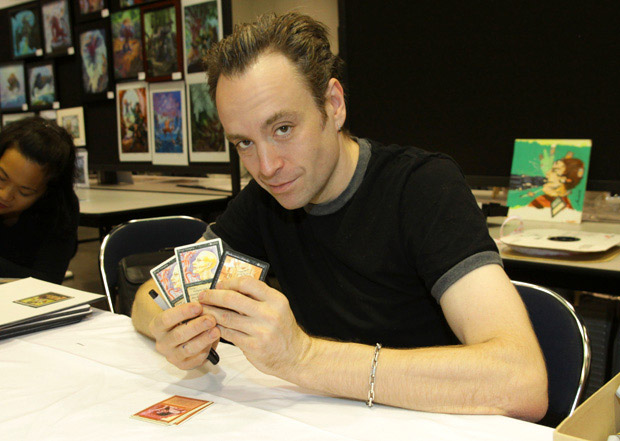
Tell us a little about how you got started in illustration, and on Magic more specifically.
I moved to Seattle in 1988 to attend Cornish College of the Arts. As a self-funded, self-supporting student, I would check out illustrations in magazines and newspapers. If I saw something I thought I could do at least as well or better, I would submit works targeting what I thought they might be looking for. I got work for the Seattle Weekly this way. A lot of my early career was a result of being open-minded and willing to juggle a bunch of projects at once.
While at Cornish I became friends with a fellow student, Andi Rusu, who told me about a guy who was looking for illustrators for a fantasy role-playing game. I learned that the guy Andi was referring to was also attending Cornish and soon had the opportunity to meet this Jesper Myrfors. He told me he worked for a local game company and to see if he thought my style would fit, he gave me a creature to illustrate.

Wizards of the Coast picked up the license for Talislanta, a fantasy role-playing game, in 1992 Happy with what I showed him, Jesper started me working on a guidebook called Thystram’s Collectanea for the role-playing game, Talislanta. The publisher of the book was Wizards of the Coast, and the entire operation was being run out of the basement of the owner, Peter Adkison’s Kent home.
Meanwhile, my lifelong friend Mark Tedin was just finishing up his master’s degree in art from St Louis. I told Mark that I had more illustration work than I knew what to do and that he should come to Seattle. That is how he ended up sleeping on the floor of my Capitol Hill apartment while we both worked on Talislanta together.
This was about a year before Magic was created and so we were already working for Wizards of the Coast by the time Magic was born.

At what point did you notice the game was a huge hit?
The funny thing about that is, Jesper Myrfors seemed to know all along that it was going to be big! His enthusiasm and excitement for the game were infectious. Jesper would say things like, “Are you ready for your name to be recognized by strangers across the world?” I would laugh it off, but I do believe in some small way it did prepare me for what was to come.
But to answer your question, for me, it was the Gen Con the year Magic was released that I realized it was a really big success. It wasn’t my first year at Gen Con but it was much different than the year before. It seemed like we had the attention of everybody there and their reactions to the game was overwhelmingly positive. We couldn’t keep up with the demand for the cards.
As far as I know, we did not bring any product back with us from GenCon. We sold everything…all of it! Then the reviews and articles started coming out from that point on it was a whirlwind.
How would you say Magic changed your career?
Before Magic, I was looking forward to doing more fine art. When I first started for Wizards I was simultaneously creating some very large paintings on my own which would be exhibited in galleries or as a part of installations. The illustration work I was getting from WotC slowly started to take over all of my time and eventually, I stopped working on other projects as they proved to have less security in it for me than Wizards’ work did.
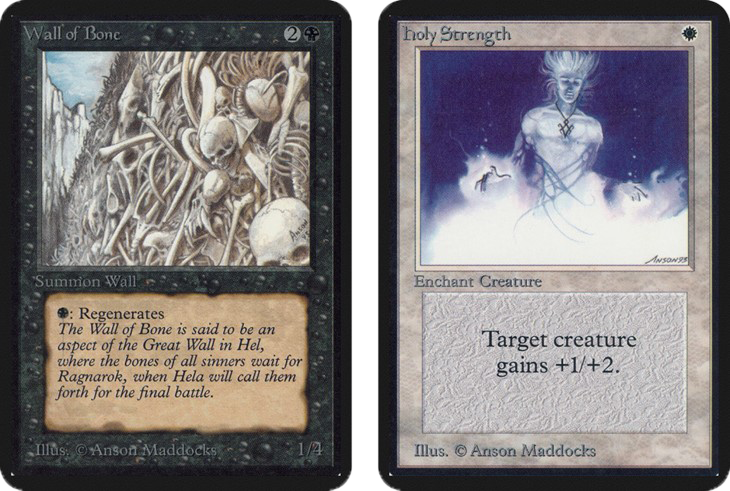
For a lot of people, the amount of money I was making under the royalties contract would be the very definition of a successful career. But to me, I sort of consider it my undoing. Because I didn’t need to, I quit working altogether. I would not advocate going from rags to riches at 23 years old. I certainly wasn’t prepared for it.
Can you give a brief description of your painting process for Magic cards?
The process when we were simply given the titles of the cards to work from was very very different from the process when we were later given two pages of typed descriptions of everything which was to be depicted in a single image!
When the title was all I had and the rest was all up to me, I wanted to make sure the result was as unexpected as I could make it. I feel like that is one of the primary roles of a visual artist (particularly a fantasy artist); to show people something which they would not have come up with on their own.

I would go to a coffee shop, get loaded on espresso, sit there all day and do everything I could do before needing to go home for the paint or ink. My favorite part was sitting across from Mark Tedin while we worked. We packed in as many productive hours into a day as we possibly could.
There were never any creative blocks back then. He was someone I knew my whole life, someone I had grown up learning to draw with. I think we both motivated each other to surpass our own expectations and for me, that was extremely beneficial. I think if you ask Mark though, he would probably say, “Anson who…?” (lol)
You worked for the game for 13 years, what changed the most during this period?
Wow, it would be an easier question to answer what didn’t change! The company, the gameplay, the art – all of it has seen its own evolution over time. I believe anything that is going to persist has to have the ability to bend and yield to the changing circumstances. Magic the Gathering has done just that.
During the years I was there what changed the most for me was the work environment and the role of the artists. Of course, this is coming from the egocentric perspective of someone who had been there from Magic’s inception.
In the beginning, we didn’t have a team of writers or entire departments devoted to design and development. So much more was entrusted to the artists and as a result, we felt a deeper sense of ownership and personal investment in the game.

Of course, as Magic experienced the massive growth it did, it made sense for the company to take the directions it did; from the decision to follow a storyline and keep continuity throughout the art to the use of digital art versus traditional art methods. I can’t argue these all weren’t the right decisions for the game. It just wasn’t really fitting with me and what I wanted to be doing at the time. If I am to be really transparent here I can’t deny that I enjoyed being something of a “star” at Grand Prix events. Back in the beginning all of the artist’s expenses were covered, and we were all treated like actual guests. We would just show up and sign cards for free…It didn’t feel like work and it took no preparation…and we would often be tipped by appreciative fans or collectors.
For artists going to events now, it is a whole different ball game. Artists are expected to pay for their own travel and usually accommodations as well, which translates into a lot of preparation to ensure the trip pays for itself and is worthwhile from a business perspective.
Merchandising, and charging for signatures, are all now necessary “evils” that just didn’t enter the equation in the beginning. What hasn’t changed, and I don’t expect will, is my love of interacting with the people who appreciate and support my artwork. That is the best part of going to events and inspires me more than you might expect!
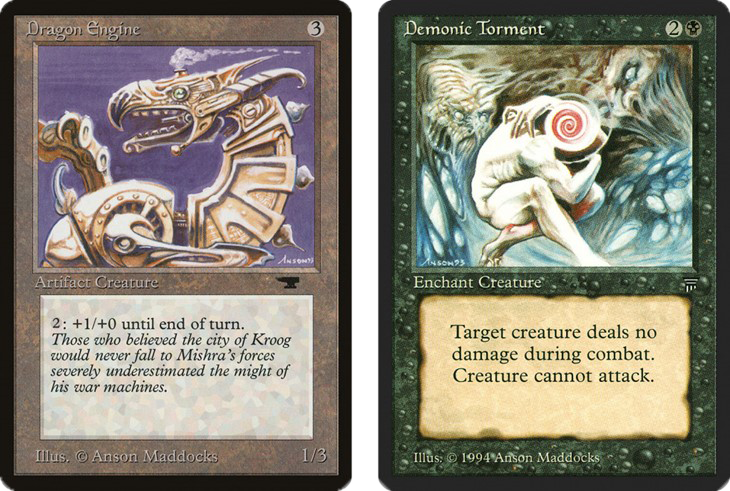
Word has it that since you were able to paint very fast, you would step up to complete pieces that other artists couldn’t finish in time. Is this true?
Yes, that is true. (Although I am not particularly proud of the fact that I worked so fast.) This was fairly common, especially when working on the Alpha set. It had a lot to do with the compensation that was being offered to the artists then which, as a fledgling company, wasn’t much. In fact, at a certain point, they had asked if the artists would be willing to accept half of their compensation in company stock, which I had agreed to. So it went from $100 per illustration to $50 (plus $50 in stock). A lot of artists, who were already having a hard time feeling motivated just dropped off. In my case, it was all about paying rent. When the compensation changed, I realized, “So now to get my rent paid, I guess I am going to have to work twice as hard!” So yeah, I took over a lot of other artists’ assignments. The other factor that played a significant role in that was my close contact with the art director, Jesper Myrfors. As I mentioned before, his enthusiasm for Magic was phenomenal. He gave me great feedback and had a way of making me feel excited about what my artwork was contributing to the game. I felt really good about working for Wizards of the Coast, I was truly enjoying the work and I didn’t want to disappoint Jesper. (I have to admit that I was also really motivated to see my art on those little cards!)

What has been your favorite plane/expansion to work on?
I am not sure that I can really differentiate one set from another back then. They all kind of seemed to be of one reality, which was a fantasy world. I mean, I loved the work I was doing at the time, don’t get me wrong. But because I started before there was a storyline and books of back-story to go along with each expansion, I don’t think it was the same experience that it is today. Although, I can say that while working on Ice Age I got the sense of a distinct place and environment and I really enjoyed it for that reason.
What were some of the most challenging cards to paint and why?
Any of the cards that came with pages of description, didn’t require me to come up with the concept. (
Of the art you made for Magic, can you name some favorites?
Cyclopean Tomb, Armor of Faith, and Pygmy Allosaurus come to mind only because when I look at these pieces I am not flooded with a bunch of things that I wish I had done differently. (Except for the number of fingers on the Pygmy Allosaurus!)
Do you still have any of your original Magic artwork?
Yes, but only a small handful of pieces. The vast majority of originals were stolen from my home quite a few years ago. The thief stole approximately 100 pieces of artwork (including 25 Alpha artworks) and boxes of sealed boosters of Alpha, Beta, Arabian Nights, and others. I reported it to the Seattle Police Department immediately however other than writing up the incident, they failed to pursue the matter.
They even had the name of the guilty party, and incontrovertible evidence but the person was never held accountable for what they did. I can not describe how devastating this event was to me and how much it impacted the course of my life. But that story could be a whole interview by itself!
For our last question, is there any Magic-related story/episode you’d like to share with us?
Well, quite a few come to mind, but most of them wouldn’t be appropriate here. But I do have a story regarding the
Pygmy Allosaurus artwork. I was at a Grand Prix event, signing cards when a young boy came through the line with his father. I am really bad about estimating age but he seemed about 6-9 years old. He definitely couldn’t have been more than 10 years old.
Anyway, a little boy. I don’t even remember if he had any cards to be signed, just his dad telling me his son wanted to ask me a question. I said, “Sure!” “Why does
Pygmy Allosaurus have only 3 fingers and not 4?” Uh um, er… Yep, schooled by this little boy on the anatomical correctness of my dinosaur artwork! I didn’t really know what to say but, I really loved that moment! In fact, the interesting stuff I learn from Magic players and collectors is one of the best parts of going to events for me. It’s truly an exceptional community and I feel fortunate to have been a part of it.
Anson can be contacted via his website, where you can find announcements about events and appearances, latest projects, and visit his web store to shop prints, artist proofs, original artwork, card alters & more!
Remember to follow Anson on Instagram.
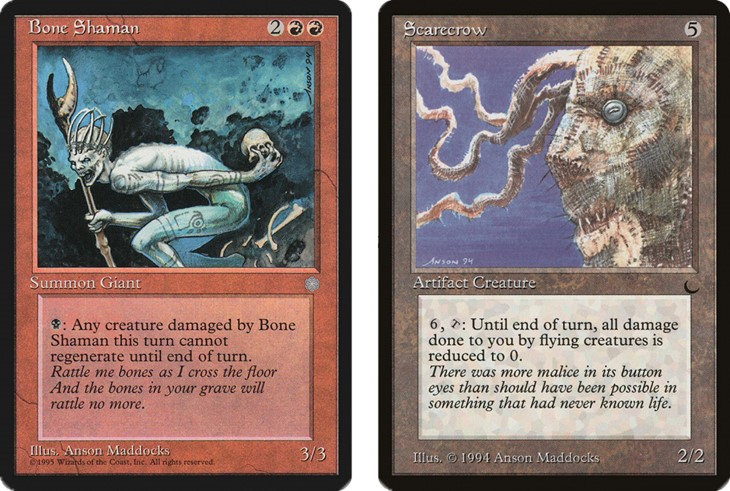
Recommended Posts

Adam Paquette Interview
Welcome to our MTG Artists Interview series There's no Magic without art. For this week's interview, we talked with Ad
Read More
Anson Maddocks Interview
Welcome to our MTG Artists Interview series There's no Magic without art. We're very happy to share with you our talk
Read More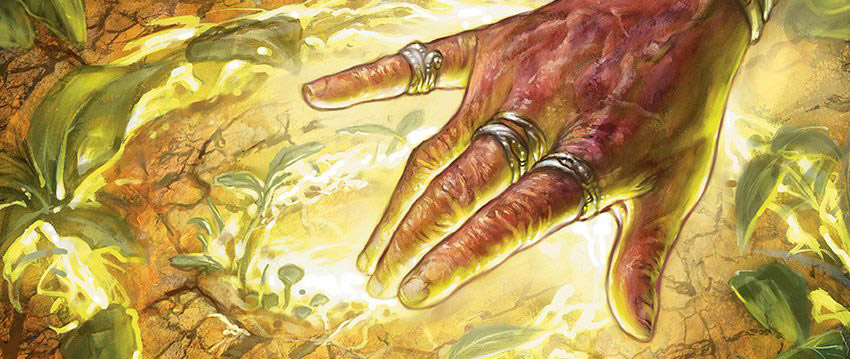
Anthony Palumbo Interview
Welcome to our Artists Interview series - There's no Magic without art - where we talk to artists about their work on
Read More